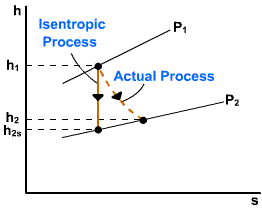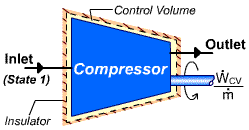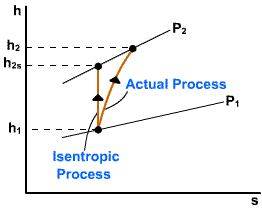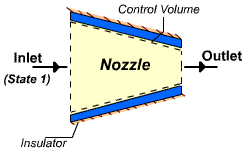|
Derivation
of Reversible Steady-Flow Work
|
||
|
For a steady-flow device undergoing an internally reversible process,
When the changes in kinetic and potential energies are negligible,
|
| Note | ||
|
|
reversible work associated with an internally reversible process in a steady-flow device | |
|
|
reversible work in closed systems | |
|
For
an Incompressible Fluid
|
||
|
Bernoulli Equation |
If
Bernoulli equation holds for incompressible flows that involve no irreversibilities such as friction or shock waves. |
|
Note:
The larger the specific volume, the larger the reversible work produced or consumed by the steady-flow device.
To minimize the work input
during a compression process
- to keep the specific volume of the working fluid as small as possible.
To maximize the work output
during an expansion process
- to keep the specific volume of the working fluid as large as possible.
|
Steam
Power Plants
|
Gas
Power Plants
|
|
| Pump
handles liquid water (small specific volume) Turbine handles vapor (large specific volume) |
Compressor
handles air (large specific volume) |
|
|
Two
Ways of Minimizing the Compressor Work
|
||
| 1. To approach an internally reversible process as much as possible by minimizing the irreversibilities such as friction, turbulence, and non-quasi-equilibrium compression. | ||
|
2. To keep the specific volume of the gas as small as possible by maintaining the gas temperature as low as possible during the compression process. This requires that the gas be cooled as it is compressed. |
Consider an isentropic process
(no cooling), a polytropic process (some cooling), and an isothermal process
(plenty of cooling) operate between the same pressure levels in an internally
reversible manner.
|
Isentropic
Process
(
|
 |
 |
|
|
Polytropic
Process
(
|
|
 |
|
|
Isothermal
Process
(pv
= constant)
|
|
Isentropic efficiency is defined as the ratio of the actual performance
of a device to the performance that would be achieved by undergoing an
isentropic process for the same inlet state and the same exit pressure.
|
Turbines
|
||
|
Actual
Turbine Work
|
 |
|
|
Rate
of Entropy Production |
||
|
Isentropic
Turbine Work
|
 |
|
|
Isentropic
Efficiency
|
 |
|
 |
 |
|
|
Compressors
|
||
|
Actual
Compressor Work
|
|
|
|
Isentropic
Compressor Work
|
 |
|
|
Isentropic
Efficiency
|
 |
|
 |
 |
|
|
Nozzles
|
||
|
Isentropic
Efficiency
|
||
 |
 |
|
